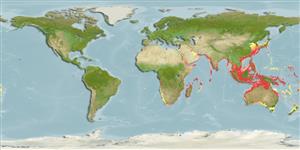Environment: milieu / climate zone / depth range / distribution range
Ecología
marino; salobre demersal; oceanodromo (Ref. 51243). Tropical
Indo-West Pacific: Red Sea and Persian Gulf to South Africa, east along the continental shores to western Pacific, from Japan to Australia (Ref. 11441). Southeast Atlantic: south coast of South Africa.
Tamaño / Peso / Age
Maturity: Lm ? range ? - ? cm
Max length : 45.0 cm SL macho / no sexado; (Ref. 559)
Short description
Claves de identificación | Morfología | Morfometría
Espinas dorsales (total) : 0; Radios blandos dorsales (total) : 11 - 13; Espinas anales: 0; Radios blandos anales: 10 - 12. Body covered with prickles. Prickles on back extending from nape to caudal peduncle (Ref. 559).
Mainly marine, occasionally enters estuaries (Ref. 4833). Occurs over sandy bottoms, often on coastal reefs; feeds on a variety of marine invertebrates (Ref. 68964).
Life cycle and mating behavior
Madurez | Reproducción | Puesta | Huevos | Fecundidad | Larva
Smith, M.M. and P.C. Heemstra, 1986. Tetraodontidae. p. 894-903. In M.M. Smith and P.C. Heemstra (eds.) Smiths' sea fishes. Springer-Verlag, Berlin. (Ref. 4919)
IUCN Red List Status (Ref. 130435: Version 2024-2)
Threat to humans
Poisonous to eat (Ref. 559)
Human uses
Pesquerías: sin interés; Acuario: Comercial
Herramientas
Special reports
Download XML
Fuentes de Internet
Estimates based on models
Preferred temperature (Ref.
123201): 19.8 - 28.4, mean 26.7 °C (based on 1253 cells).
Phylogenetic diversity index (Ref.
82804): PD
50 = 0.5005 [Uniqueness, from 0.5 = low to 2.0 = high].
Bayesian length-weight: a=0.02239 (0.01375 - 0.03645), b=2.86 (2.73 - 2.99), in cm total length, based on LWR estimates for this species & Genus-body shape (Ref.
93245).
Nivel trófico (Ref.
69278): 3.7 ±0.4 se; based on size and trophs of closest relatives
Resiliencia (Ref.
120179): Medio, población duplicada en un tiempo mínimo de 1.4-4.4 años (Preliminary K or Fecundity.).
Fishing Vulnerability (Ref.
59153): Moderate vulnerability (42 of 100).
